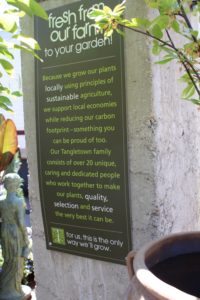
Growing Customers
Catch Phil at the ProGreen EXPO from Feb. 13-16, 2018, in Denver, Colorado. He’ll be tackling “The Right Stuff: Content that Customers Love and Sells Products.” Visit www.progreenexpo.com for more information.
The next time you’re in traffic behind someone looking at a cell phone or watching an employee hide in a bathroom stall to change their Facebook status … be grateful.
You see, this little device has opened up a whole new highway for all of us to reach millions of potential enthusiasts.
The average smartphone user spends 83 hours a month browsing the internet.
Every year at this time garden center owners declare: “This is the year I am going to really work the internet.” We go to trade shows, we read articles, we admire how the big guys do it, and we remember that last year we had good intentions too.
We said yes to the blogging, Tweeting, Pinteresting, Instagramming, Snapchatting and being connected. We know it can’t happen, but it’s such a good idea we keep saying yes to it!
These great intentions turn into confessions of neglect. I’m here to tell owners: “It’s not you!”
The very best, hardest working, most organized owners can’t spin the plate of e-marketing through a season. It always falls casualty to the less important but more urgent business of running a business.
It’s not a reflection of irresponsibility. Slacking on social media and e-marketing is a very natural consequence of running a successful business.
So if insanity is defined as “doing the same thing over and over expecting different results,” then let’s step into the discomfort of change and do something different.
Here is a four-step program to follow.
The Website
Step one is having a nice website. I suggest people see this as a continuum and proceed to make it a living thing that gets better year after year.
The key is tending to it (sounds like a garden, right?). I want to show you the natural progression a site should follow. The best sites are the result of a progression, not an event.
We start with the most basic website.
This website has our hours, directions, delivery areas, key contacts and some reason for folks to come see us. It should have seasonal photos and answer the most basic questions. What are your hours, how do I get there, and what is your phone number? This site doesn’t give people a reason to return. It doesn’t draw in new customers as much as it serves existing customers.
Next we have a website worth returning to.
This site will have data that changes. It will have a garden guide for the current month. It will have a few project ideas with photographs. It could highlight employees with areas of expertise. It might offer me the chance to buy a gift card. It should have some before and after photos.
This will require attention each month but will reward people who come back. It might also sell people across departments. A retail customer might become a landscape service customer or vice versa.
As we move to higher ground we find a website that is worthy of the top position on the search engines.
This website gets brand new customers, and it provides literally 1,000 reasons to visit. It gets very high marks for many search terms. It has galleries of plants you carry, so if someone searches for “arborvitae” you come up. It has care sheets for pest control. It promotes workshops and invites people to each new season.
If someone Googles “white powder on roses,” then you come up. If people are choosing between stores, you win because you demonstrated your expertise and commitment to your customers.
Now most people don’t go from zero to 60 on this scale. Consider your website a base to grow from. As we proceed you see how this is the base of your marketing.
Outbound Communication
Next we consider “outbound communication.”
This is often called push marketing. We don’t wait for people to go to a search engine when they are looking. Instead we reach out to them with a suggestion. If we do this correctly, they are very grateful, more successful and become your advocate.
The start of this is a simple newsletter sent once a month.
We remind the gardener of what should be pruned, fed, planted or separated that month. We suggest a family project or two. We give them an idea of what to be on guard for. There might be a special opportunity like a seminar they can sign up for, or a coupon.
We want to reward people for opening this newsletter and realize that if we don’t make this beneficial for them we could end up like the 80 percent of emails that get deleted without even being opened. If you do this well, you will see huge open rates. You will drive sales and build relationships that turn buyers into friends.
This can progress to be weekly emails in season.
You can highlight successful landscape installations or help the Cub Scouts promote a car wash. This could be a tool to find new hires or highlight exceptional employees. This is not a vehicle to just send out pricing and coupons. Open rates and redemptions are very poor if there is not valuable content.
We survey customers and have learned some things that lead us to have exceptionally high open rates for our newsletters.
The first thing is almost nobody considers themselves expert gardeners. Many people who have been enthusiasts for decades still consider themselves students with much to learn. We also learn that one of the qualities of a well-read newsletter is the way it inspires readers. You are showing them what could be.
Engagement Marketing
The next progressive step after email newsletters is “engagement marketing.”
This is posting a few care videos to YouTube, posting on Facebook, Instagram and/or Snapchat. This only takes a few minutes if you know what it is you want to promote. When this runs well you are seeing customer responses and initiating conversations. This is the same communications garden centers have been doing for generations — only the means of the communications has changed.
Simple questions like “Is it too early to plant vegetables?” or “How big of a pot will I need to plant a rose bush?” get asked and answered
as an audience gets hungry to garden and gets closer to being successful at it. Don’t let the medium scare you because you have the experience and knowledge, and this allows you to showcase that.
All of the things we have mentioned above are basically free. These are the ways we communicate with people who have in one way or another opted into our communications. It might be signing up for a newsletter or following us on Twitter.
Paid Placement
The next step for growing our business comes from “renting eyeballs.”
This is paid placement. It’s not for everyone, and it is not for all of the time. There, however, are some wonderful opportunities here. Let me highlight two opportunities here.
Google AdWords is the most common. This puts your ad in front of people on Google and affiliated sites. Imagine someone going to YouTube to see a video about making a pollinator garden when your ad appears telling them how you can help.
Advertising on Facebook is my personal favorite vehicle for a garden center.
We can target an audience by a restaurant they like, or a school, or a church. We write content to tickle their interest and bring them to our site. Then when they like our Facebook page, we are tickling them each week with a reason to come into the garden center.
Facebook budgets can be $20 a week and give us business we would have never had.
Consider targeting people for firewood, or a seminar, or a service offering. We can fill seminars, attract new employees or grow a service area like pond openings or spring clean ups.
This year you can take a mighty step forward.
Use the off season to make your spreadsheet and coordinate your content. Write articles beforehand. Seed your website with care guides and handouts. Engage staff to promote their departments. Strive to make progress and not achieve perfection. I know you can do it.


















 Videos
Videos





